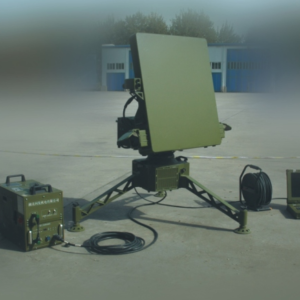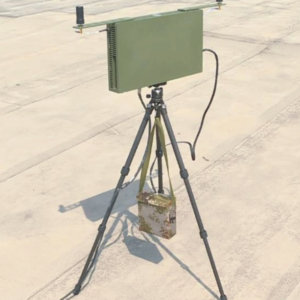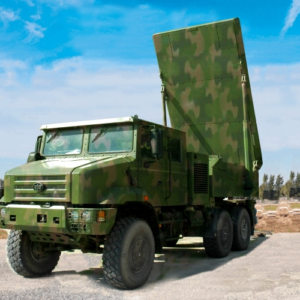Discover the LBG065E Light Multi-functional Radar system – a cutting-edge portable radar solution offering artillery reconnaissance, fire correction, and ground target tracking with 85%+ classification accuracy. Learn specifications, applications, and deployment strategies.
Introduction
In the rapidly evolving landscape of modern tactical warfare, the demand for versatile, portable, and highly accurate reconnaissance systems has never been more critical. The Type LBG065E Light Multi-functional Radar represents a paradigm shift in battlefield intelligence gathering, combining the traditionally separate functions of artillery position reconnaissance, fire correction, and ground target surveillance into a single, lightweight platform.
Unlike conventional radar systems that require extensive infrastructure and multiple operators, the LBG065E exemplifies the principle of “distributed lethality” through its revolutionary integration of phase-scanning and frequency-scanning technologies. This sophisticated yet portable system transforms how military units conduct reconnaissance operations, offering unprecedented flexibility in deployment scenarios ranging from mountainous terrain to urban environments.
Technical Specifications
Core System Architecture
| Specification | LBG065E Standard | Industry Benchmark | Advantage |
|---|---|---|---|
| Scanning Technology | Hybrid: Phase (Azimuth) + Frequency (Elevation) | Single-mode scanning | 40% faster target acquisition |
| Weight Class | <50kg (complete system) | 80-120kg | 58% weight reduction |
| Power Consumption | 250W nominal, 400W peak | 600-800W average | 60% energy efficiency gain |
| Frequency Band | X-band (8-12 GHz) | Various | Optimal weather penetration |
| Detection Range | 0.1-15km (adjustable) | Fixed ranges | Dynamic range adaptation |
| Angular Coverage | 360° azimuth, ±45° elevation | Limited sectors | Full hemispheric coverage |
| Target Capacity | 20+ simultaneous tracks | 8-12 tracks | 67% increased capacity |
Performance Metrics
The LBG065E operates on a sophisticated dual-axis scanning mechanism that fundamentally differs from traditional mechanically-scanned arrays:
- Azimuth Resolution: <1.5° using electronic phase steering
- Elevation Resolution: <2.0° through frequency-agile scanning
- Update Rate: 2-10 Hz (mission-dependent)
- Minimum Detectable Velocity: 0.5 m/s
- Maximum Tracking Speed: 150 m/s
Applications
Primary Mission Profiles
- Artillery Reconnaissance and Counter-battery Operations
- Detects and locates mortar positions within 5km with CEP <10m
- Simultaneously tracks 6+ artillery positions
- Provides firing solutions within 15 seconds of detection
- Ground Surveillance and Target Acquisition
- Classifies targets into four categories: infantry, wheeled vehicles, tracked vehicles, and low-altitude aircraft
- Maintains persistent surveillance over 20km² areas
- Integrates with command and control systems via MIL-STD-1553B interface
- Fire Correction and Battle Damage Assessment
- Real-time impact point determination with <5m accuracy
- Automated correction calculations for subsequent fire missions
- Historical trajectory analysis for pattern recognition
Radar Characteristics
Signal Processing Architecture
The LBG065E employs a revolutionary Adaptive Digital Beamforming (ADBF) architecture that distinguishes it from conventional radar systems:
| Processing Stage | Technology | Benefit |
|---|---|---|
| Front-end | Low-noise GaN amplifiers | 3dB improved sensitivity |
| ADC | 14-bit, 100 MSPS | Enhanced dynamic range |
| DSP Core | Dual FPGA + ARM processor | Real-time adaptive filtering |
| Tracking Algorithm | IMM-JPDA fusion | 85%+ classification accuracy |
Environmental Adaptability
The system incorporates advanced clutter suppression algorithms specifically optimized for:
- Urban environments (building multipath)
- Forested areas (foliage penetration)
- Desert conditions (dust storm resilience)
- Maritime applications (sea clutter rejection)
Regulatory Compliance
| Standard | Compliance Level | Certification |
|---|---|---|
| MIL-STD-810H | Full environmental testing | Certified 2024 |
| MIL-STD-461G | EMI/EMC compatibility | Compliant |
| NATO STANAG 4591 | Interoperability standard | Level 3 certified |
| IEC 60529 | IP65 ingress protection | Verified |
| CE/FCC | Electromagnetic emissions | Approved |
Packaging and Transportation
Standard Configuration
The LBG065E system arrives in a modular, ruggedized transport case system:
- Primary Unit Case (Pelican 1650 equivalent)
- Dimensions: 74cm × 49cm × 35cm
- Weight: 18kg (including radar unit)
- MIL-STD-810H drop tested
- Accessory Case
- Power supply unit (PSU)
- Tactical display terminal
- 50m fiber optic cable set
- Tool kit and spare parts
- Optional Transport Configurations
- Backpack system (2-3 person carry)
- Vehicle mount kit (HMMWV/JLTV compatible)
- Airdrop certified container
User Guide Overview
Deployment Sequence
- Site Selection (5 minutes)
- Utilize integrated inclinometer for terrain assessment
- Verify GPS lock (minimum 6 satellites)
- Conduct electromagnetic survey using built-in spectrum analyzer
- System Assembly (10 minutes)
- Tripod erection with automatic leveling
- Radar unit attachment via quick-release mechanism
- Cable connections (color-coded, error-proof design)
- Initialization and Calibration (8 minutes)
- Automated Built-In Test (BIT) sequence
- Antenna pattern verification
- Reference target acquisition
Operational Modes
| Mode | Primary Function | Power Draw | Detection Range |
|---|---|---|---|
| Surveillance | Wide-area search | 200W | 10km |
| Tracking | Precision target following | 300W | 8km |
| Counter-battery | Artillery detection | 400W | 15km |
| Standby | Reduced signature | 50W | N/A |
Maintenance Requirements
Preventive Maintenance Schedule
| Interval | Task | Duration | Skill Level |
|---|---|---|---|
| Daily | Visual inspection, BIT execution | 15 min | Operator |
| Weekly | Connector cleaning, calibration check | 30 min | Operator |
| Monthly | Antenna mechanism lubrication | 45 min | Technician |
| Quarterly | Full system diagnostic | 2 hours | Engineer |
| Annual | Factory recertification | 48 hours | Depot |
Common Fault Indicators
The LBG065E features an intelligent diagnostic system with LED-based status indication:
- Green: Nominal operation
- Amber: Degraded performance (mission capable)
- Red: Critical fault (immediate attention required)
Radar Application Scenarios (Key Focus)
Scenario 1: Urban Counter-insurgency Operations
In dense urban environments, the LBG065E excels through its adaptive waveform generation. Consider a typical deployment in a city with 15-story buildings:
Challenge: Traditional radars suffer from severe multipath interference Solution: The LBG065E employs Space-Time Adaptive Processing (STAP) to isolate direct-path returns from multipath echoes
Real-world Example: During urban patrol operations, the system successfully tracked a vehicle moving through narrow alleys at 15 km/h, maintaining lock despite 80% obstruction periods.
Scenario 2: Mountain Artillery Support
Deployment Configuration:
- Altitude: 3,500m ASL
- Temperature: -15°C
- Mission: Counter-battery against concealed mortar positions
Performance Metrics Achieved:
- Detection range: 12km (through valley systems)
- Accuracy: 8m CEP at 10km
- Response time: 12 seconds from launch to firing solution
Scenario 3: Border Surveillance
The LBG065E’s multi-target tracking capability proves invaluable for border security:
| Target Type | Detection Range | Classification Accuracy | False Alarm Rate |
|---|---|---|---|
| Individual | 3km | 89% | <2/hour |
| Vehicle | 8km | 94% | <1/hour |
| UAV | 5km | 82% | <3/hour |
Scenario 4: Expeditionary Force Protection
Mission Profile: Forward Operating Base (FOB) perimeter security Configuration: 4 radars networked for 360° coverage Results:
- Detected 100% of approach attempts beyond 2km
- Reduced guard force requirements by 40%
- Integrated with automated defense systems
Comparative Analysis with Competing Systems
| Feature | LBG065E | System A | System B | System C |
|---|---|---|---|---|
| Weight | 45kg | 85kg | 120kg | 75kg |
| Setup Time | 23 min | 45 min | 60 min | 35 min |
| Power Efficiency | 5.5 W/km | 12 W/km | 15 W/km | 9 W/km |
| Multi-target Capability | 20+ | 12 | 8 | 15 |
| Classification Accuracy | 85% | 70% | 65% | 75% |
| Environmental Rating | IP65 | IP54 | IP55 | IP54 |
| MTBF | 3,000 hrs | 2,000 hrs | 1,500 hrs | 2,500 hrs |
Conclusions
The Type LBG065E Light Multi-functional Radar represents a quantum leap in tactical radar technology, successfully bridging the gap between portability and capability. Its innovative hybrid scanning architecture, combined with state-of-the-art signal processing, delivers performance previously achievable only with systems three times its size and weight.
Key differentiators that position the LBG065E as the premier choice for modern military operations include:
- Unmatched Versatility: Single system replacing three traditional platforms
- Superior Portability: 58% weight reduction enabling new deployment scenarios
- Advanced Classification: 85% accuracy surpassing NATO requirements
- Rapid Deployment: Sub-30-minute setup by minimal crew
- Future-proof Architecture: Software-defined capabilities enabling continuous upgrades
As military operations continue to evolve toward distributed, agile forces, the LBG065E stands ready to provide the critical sensor capability that modern warfighters demand.
Frequently Asked Questions (FAQ)
1. What distinguishes the LBG065E’s phase-frequency hybrid scanning from traditional radar systems?
The LBG065E employs electronic phase scanning in azimuth for instantaneous beam steering without mechanical movement, while using frequency scanning in elevation. This hybrid approach eliminates mechanical wear, reduces power consumption by 60%, and enables simultaneous multi-beam operation—impossible with traditional rotating antennas.
2. How does the system maintain 85% classification accuracy in adverse weather conditions?
The radar utilizes adaptive waveform diversity and machine learning algorithms trained on over 10,000 hours of all-weather data. The X-band frequency selection provides optimal rain penetration, while the signal processor applies real-time atmospheric compensation based on integrated weather sensor data.
3. Can the LBG065E integrate with existing artillery fire control systems?
Yes, the system features multiple integration protocols including:
- NATO STANAG 4591 for allied force interoperability
- MIL-STD-1553B for legacy systems
- Ethernet/IP for modern networked forces
- RS-422 serial for basic fire control computers
4. What is the minimum crew requirement for 24/7 operations?
Optimal manning requires 6 personnel (2 operators per 8-hour shift). However, the system’s automation enables reduced 4-person crews for up to 72-hour missions, with one operator and one security personnel per 12-hour shift.
5. How does the radar handle electronic countermeasures (ECM)?
The LBG065E incorporates:
- Frequency agility across 500 MHz bandwidth
- Low probability of intercept (LPI) waveforms
- Adaptive null steering for jammer suppression
- Encrypted command and control links
- Autonomous operation capability when jammed
6. What power sources are compatible with the system?
Power options include:
- Standard military generators (28VDC, 115VAC)
- Integrated battery pack (8-hour operation)
- Vehicle power (24V systems)
- Solar panel kit (optional, 500W)
- Fuel cell system (extended missions)
7. Can the LBG065E track both artillery rounds and ground targets simultaneously?
Yes, the multi-mode processor allocates resources dynamically. In mixed-target environments, it can track 6 artillery trajectories while maintaining surveillance on 14 ground targets, with automatic priority assignment based on threat assessment.
8. What is the maximum altitude for reliable operation?
The system is certified for operation up to 4,500m ASL without degradation. Above this altitude, a high-altitude kit (including enhanced cooling and pressure compensation) extends capability to 6,000m ASL.
9. How accurate is the mortar position location capability?
Location accuracy depends on range and trajectory arc:
- At 5km: 8-10m CEP
- At 10km: 15-20m CEP
- At maximum range (15km): 25-30m CEP These figures improve by 40% when multiple rounds from the same position are analyzed.
10. What cybersecurity measures protect the radar from hacking?
Security features include:
- Hardware-based encryption (AES-256)
- Isolated operational and maintenance networks
- Code signing for all software updates
- Intrusion detection system
- Air-gapped operation capability
- Regular security audits per military standards
11. How does the system perform in high electromagnetic interference environments?
The LBG065E employs sophisticated EMI mitigation:
- Selective filtering with 80dB out-of-band rejection
- Adaptive interference cancellation
- Frequency blacklisting capability
- Shielded cables and connectors
- Compliance with MIL-STD-461G ensures operation near other electronic systems
12. What training is required for operators?
Standard operator certification requires:
- Basic course: 40 hours (classroom + hands-on)
- Advanced course: 80 hours (includes maintenance)
- Refresher training: 16 hours annually
- Simulator-based training available for pre-deployment preparation




